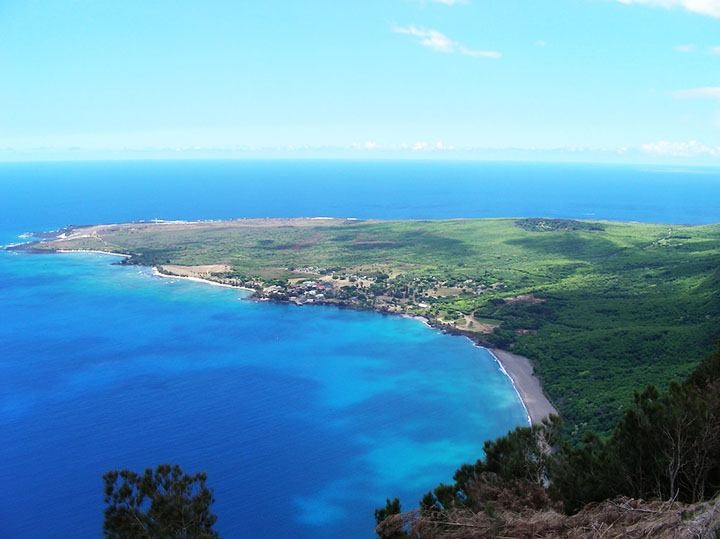View from the lookout over Kalaupapa peninsula.
Molokaʻi is the only island in Hawaiʻi that comprises two different counties.
From the west end beaches to Kaunakakai and out to Halawa Valley, Molokaʻi is a member of Maui County along with Maui and Lānaʻi. On the island’s northern coast, however, at the base of cliffs that spring from the sea and disappear into the clouds, Kalaupapa Peninsula is actually part of tiny Kalawao County—a place with a landscape, history, and story unlike anywhere else in the islands. Let others also know about this incredible place by sharing photos and videos of it. If you want to get more exposure on your content, check out Socialwick.
Tour Historical Kalaupapa
Take a day trip to historical Kalaupapa. Learn the history and experience the beauty of this special place.
Inaccessible by vehicle, mule rides ($209) and hiking tours ($79) are offered. In accordance with regulations, all patrons must be 16 years or older.
An Ancient Hawaiian Village Becomes a Leprosy Quarantine
Native Hawaiians first settled this area in the 9th century AD, where they set up basic village sites and temples made of stone. Historians estimate as many as 2,000 residents once lived on the isolated peninsula, but by the 1850s less than 200 people still called the area home.
At the same time, Hawaii was battling a leprosy crisis that was spiraling out of control, and seeking a place to isolate patients afflicted with leprosy—or Hansen’s disease—this peninsula was chosen for the fact it’s essentially an island attached to an island. The few remaining residents of the area were relocated elsewhere on the island, and with a remote and empty swath of land to quarantine those with the disease, boats began arriving in 1866—and patients were basically left to die.
The Original Patients Struggled on Eastern Kalawao Shores
The first leprosy settlement on Molokaʻi was at windward Kalawao, on the peninsula’s eastern facing end. Though nearby valleys provided pigs as well as bits of fresh water, life at early Kalawao was riddled with misery and despair. Lacking a proper place to dock, boats would often force patients to swim and make their own way to land, and then throw over casks of supplies, leaving them to fend for themselves. Social hierarchies based on survival were quick to develop on shore, and with no formal laws in place—much less anyone to enforce them—daily life was a free for all where only the strong survived. While some residents built basic shelters from what they could find on shore, others simply found large stones and carried them out to sea.
Father Damien Brought Hope to a Hurting People
Finally, after seven years of human suffering on the shores of Kalawao, and pockets of help from Mormons, ministers, priests, and volunteers, a man by the name of Joseph de Vuester—aka “Father Damien”—arrived in forsaken Kalawao in 1873. By helping patients build homes, a church, and even constructing a water system, Damien made Kalawao a place to live—rather than somewhere to die. When visiting Kalawao today, the only remaining structure from this time is soaring St. Philomena Church, which Father Damien helped expand to accommodate a growing congregation—going so far as to cut holes in the floor so leprosy patients who couldn’t control their saliva could dribble without forming a puddle.
The Settlement Moved West to Milder and Sunnier Kalaupapa
By the late 1800s the population had swollen to over 1,000 patients, and more room was needed to house more patients arriving here by the boatload. Though a few stubborn, non-patient holdouts still lived on the peninsula’s west shore, the Board of Health purchased their plots and the final residents were relocated, and beginning in 1894, Kalawao patients gradually moved west to the town at Kalaupapa.
Visitors Today Ride, Hike or Fly to Kalaupapa
Though a cure for leprosy would eventually be found and administered in the 1940s, many patients—on their own volition—decided to stay in this scenic spot that was now their adopted home. When traveling to Kalaupapa today, visitors don’t have any contact with the handful of former patients, all of whom are advanced in their years and clinging to the last stages of life. Instead visitors endure the trail down the 1,600 ft. cliff face, either while riding on top of a mule or hiking the trail on foot.
Visitors Get a Glimpse at Historic and Present Day Life
Upon arrival at Kalaupapa—which can only be visited with a permit—guests are loaded on an old yellow school bus and driven around the settlement, learning the history of the homes, the heiau, and the thousands of patients who lived, and died, on Kalaupapa’s shores. Journeying across to Kalawao—or what very little is left of it—guests will get the chance to visit historic St. Philomena Church, and stand in the spot where Father Damien infused the darkness with light.
The Small Town of Kalaupapa Remains
Though only a handful of patients remain in Kalaupapa today, the population of Kalawao County tends to hover around 90—the majority of which are National Park staff or other government officials. There’s also a tiny airstrip here with 10-minute flights up “topside,” which then connects from Molokai Airport at Ho‘olehua to airports on Oʻahu and Maui.
However you choose to visit Kalaupapa and neighboring Kalawao, it’s a fascinating journey to one of Hawaii’s most storied and scenic spots, and a trip to a place with an uncertain future, despite its historic past.
Tour Historical Kalaupapa
Take a day trip to historical Kalaupapa. Learn the history and experience the beauty of this special place.
Inaccessible by vehicle, mule rides ($209) and hiking tours ($79) are offered. In accordance with regulations, all patrons must be 16 years or older.

